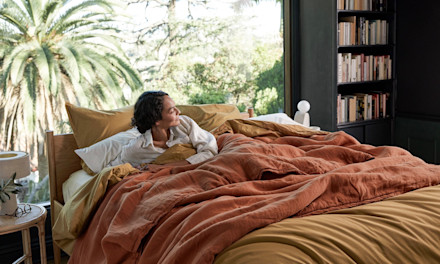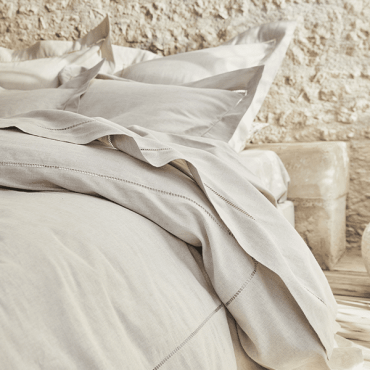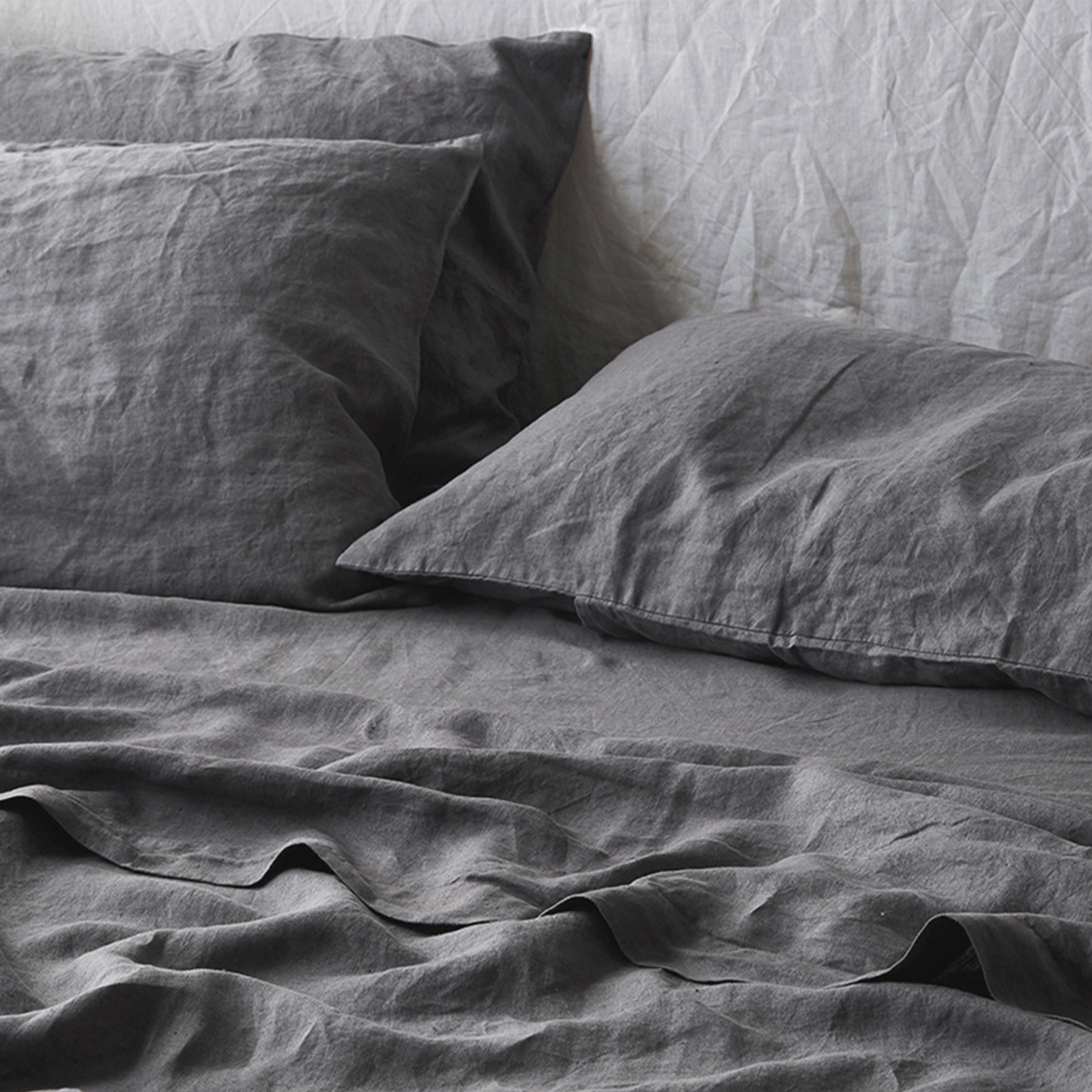Comprehending Bed Linen: The Eco-Friendly Choice for Comfortable Living
When you assume concerning environmentally friendly fabrics, bed linen commonly stands out for its special top qualities. What genuinely establishes bed linen apart from various other products? Let's explore the interesting globe of linen even more.
The Beginnings of Linen: From Flax to Material

Linen, among the oldest fabrics known to mankind, has an interesting journey that begins with the modest flax plant. You could be stunned to find out that this plant prospers in amazing climates, thriving in regions like Europe and components of Asia. As soon as collected, the flax stalks undergo a process called retting, where they're soaked to separate the fibers from the woody parts. After retting, the fibers are brushed and rotated into yarn, ready for weaving.
When you see linen textile, you're seeing centuries of craftsmanship. The weaving procedure changes those spindles of string into the lovely, resilient cloth you like. Linen has been treasured for its natural appearance and really feel, making it a preferred for whatever from garments to home textiles. So, next time you touch bed linen, remember its rich background that attaches you to ancient societies and their standard practices - Linen Australia.
The Distinct Feature of Bed Linen
One of the standout attributes of this amazing material is its breathability. When you wear linen, you'll see how it allows air to distribute, keeping you cool on hot days. This property makes it a best option for summer clothes and bedding.
Bed linen also flaunts extraordinary moisture-wicking abilities, drawing sweat away from your skin and permitting it to evaporate rapidly. You won't feel clammy, even in damp conditions. Additionally, bed linen is sturdy, typically becoming softer and much more comfortable with each clean, which means it can stand the test of time in your closet.
An additional one-of-a-kind facet is its all-natural structure; the slight irregularities provide bed linen a character that improves your design. Plus, it resists wrinkles better than many various other materials, so you can enjoy a loosened up yet brightened look without much effort. Welcome bed linen, and you'll appreciate its convenience and distinct beauty.
Ecological Advantages of Bed Linen
When you select bed linen, you're not simply choosing a gorgeous textile; you're additionally sustaining lasting production techniques. Bed linen's compostable and naturally degradable nature makes it a smart selection for the atmosphere. Plus, it needs substantially less water to produce contrasted to various other textiles, helping conserve this valuable resource.
Lasting Manufacturing Practices
Although numerous fabrics have considerable ecological influences, bed linen stands out due to its sustainable production practices. When you select linen, you're choosing for a material made from the flax plant, which needs very little water and chemicals.
Linen production is often much less energy-intensive compared to other textiles, as it involves all-natural procedures as opposed to synthetic therapies. By sustaining bed linen, you're adding to a more lasting fabric market that prioritizes environment-friendly methods. Picking bed linen not just enhances your comfort but also aligns your worths with environmental responsibility.
Compostable and naturally degradable Material
Bed linen's green nature expands past its lasting production; it's also biodegradable and compostable, making it an excellent option for eco aware customers. When you pick linen items, you're choosing for products that break down naturally, returning nutrients to the earth. Composting linen can improve dirt, promoting healthy and balanced plant growth.
Low Tide Intake
One of the standout advantages of linen is its low tide intake during growing. Unlike cotton, which needs considerable irrigation, linen's flax plant flourishes on minimal water, making it a more lasting option. You'll value recognizing that for every single bunch of linen produced, substantially much less water is required contrasted to many other textiles. This means that selecting linen helps preserve essential freshwater sources, which is crucial in today's environment. In addition, bed linen's natural dry spell resistance allows it to grow in less-than-ideal problems, further reducing its ecological effect. By choosing bed linen, you're not simply investing in top quality; you're also supporting a textile that advertises liable water usage and adds to a much healthier world for future generations.
Bed linen vs. Other Fabrics: A Comparison
When you contrast linen to various other fabrics, you'll observe its premium breathability and comfort, making it perfect for cozy climate. Plus, bed linen sticks out for its durability and longevity, usually outlasting lots of generally utilized materials. As you consider your selections, the environmental impact of each material will certainly additionally play a necessary duty in your decision.
Breathability and Convenience
Breathability is a key consider selecting materials for comfort, specifically in cozy weather. Linen sticks out among products for its amazing capacity to enable air blood circulation. Unlike artificial materials, which can trap warmth and dampness, linen's all-natural fibers wick away sweat, maintaining you awesome and completely dry. When you put on linen, you'll notice exactly how it really feels light against your skin, improving your comfort during hot days.
Cotton is commonly applauded for its gentleness, yet it doesn't match bed linen's breathability. Even blends could not offer the very same ventilation. If you prioritize convenience, especially in summer season, bed linen must be your go-to option. It not only maintains you feeling fresh but additionally brings a classic beauty to your wardrobe.
Resilience and Longevity
While many textiles use differing degrees of longevity, bed linen really masters longevity, making it a sensible investment for your closet. Unlike cotton or synthetic products that might use out rapidly, bed linen obtains stronger with each clean. Its all-natural fibers withstand fading and fraying, guaranteeing your garments look great gradually. You'll find that bed linen's breathable nature likewise lowers wear from sweat and wetness, which can damage other fabrics. Plus, its capability to stand up to high temperature levels means it won't reduce conveniently in the dryer. When you choose bed linen, you're opting for a durable material that can deal with everyday usage while maintaining its charm. Believe me, your long-term investment in linen will pay off with years of fashionable, comfy wear.
Environmental Effect Comparison
Although many fabrics add to ecological problems, linen stands out for its environment-friendly qualities. Unlike cotton, which needs large water resources and pesticides, linen is made from flax, a plant that prospers on marginal water and requires fewer chemicals. This means you can feel great regarding your selection while reducing your carbon footprint.
When compared to synthetic textiles like polyester, bed linen's biodegradability radiates. While polyester can take centuries to decompose, bed linen breaks down normally, returning nutrients to the soil.
Choosing bed linen not only promotes sustainable farming practices yet likewise sustains a much healthier planet. By choosing linen over traditional fabrics, you're making a conscious choice that benefits both your convenience and the atmosphere.
Caring for Your Linen Textiles
To assure your linen textiles stay in great problem, you'll want to comply with some straightforward treatment standards. Clean your bed linen in cool water on a gentle cycle to stop it from reducing or losing its shape.
When it involves drying out, air drying is finest. Pick a low warm setting and eliminate the products while they're still a little damp to reduce wrinkles if you use a dryer. Iron the bed linen while it's still damp for much easier handling, or steam it to keep it looking crisp.
For storage space, keep your linen in an awesome, dry place. Stay clear of straight sunlight to avoid fading. With these straightforward practices, your bed linen fabrics will preserve their elegance and last for many years, making them a sustainable enhancement to your way of living.
Incorporating Linen Into Your Home Style
Looking after your linen fabrics not only preserves their quality however also opens up a globe of possibilities for integrating them right into your home decoration. You look at here now can start tiny by adding bed linen toss pillows to your sofa, instantaneously raising the room with structure and warmth. Think about bed linen curtains that filter sunlight beautifully, developing a soft, ventilated ambience in any type of space.
For a more rustic appearance, attempt making use of bed linen table linens or joggers throughout dishes; they include an elegant touch and are easy to tidy. If you're feeling daring, mix and match various bed linen colors and patterns to develop a distinct, split impact.
Don't neglect regarding bed linen coverings-- drape one over a chair or your bed for a welcoming feeling. By thoughtfully integrating linen find this right into your design, you boost both convenience and style, making your home a peaceful retreat.
The Future of Bed Linen in Sustainable Living
As customers progressively focus on sustainability, linen emerges as a frontrunner in green fabrics. Its manufacturing makes use of less water and pesticides compared to traditional cotton, making it a much more environmentally liable selection. As you look towards a lasting future, incorporating bed linen right into your closet and home can greatly decrease your carbon footprint.
Innovative brand names are currently concentrating on lasting techniques, from using natural flax to applying circular economic climate principles. You'll locate that bed linen's toughness means it lasts longer, reducing the demand for frequent replacements.
Moreover, as more people accept minimalist way of lives, linen's ageless allure and adaptability will certainly keep it relevant. By selecting bed linen, you're not just going with comfort; you're also supporting lasting methods.
In the upcoming years, the need for linen is anticipated to expand, strengthening its area in a much more eco-conscious globe. So, take into consideration making bed linen a staple in your lasting living trip.
Regularly Asked Questions
Is Linen Ideal for People With Allergies?
Yes, bed linen's natural fibers are hypoallergenic, making it suitable for people with allergies. Its breathable nature helps in reducing dampness and bacteria buildup, adding to a healthier resting atmosphere. You'll likely locate it safe and comfortable.
Can Linen Be Colored Easily?
Yes, you can color linen quickly. Its natural fibers soak up dyes well, enabling vivid colors. Just ensure you utilize the ideal color kind and follow appropriate methods to accomplish the desired results without harming the textile.
Exactly How Does Linen Contrast in Longevity to Cotton?

What Weight of Bed Linen Is Best for Summer Clothing?
For summertime garments, lightweight bed linen around 4 to 5 ounces per lawn is excellent. It keeps you great, breathable, and comfortable in heat (Linen Australia). You'll appreciate just how it drapes and actions with you effortlessly

Can Linen Be Used for Outdoor Furnishings?
Yes, you can utilize linen for outdoor furniture. It's breathable and long lasting, making it a terrific choice for warm climate. Simply be sure to choose a dealt with version to hold up against the elements and maintain its look.
Final thought
Integrating linen into your life not just boosts your comfort however also sustains an extra sustainable future. With its distinct buildings and minimal environmental influence, linen is a clever option for your home design and lifestyle.
Linen's compostable and eco-friendly nature makes it a wise option for the environment. By integrating try this bed linen right into your home, you're not simply appreciating its comfort and sturdiness; you're likewise supporting green practices and aiding produce a much healthier earth. The Future of Linen in Lasting Living.
